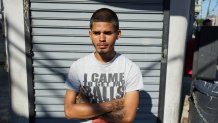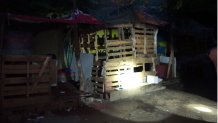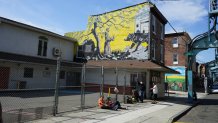Heavy, wet snowflakes clung to Zinqueece Giddings’ military-style school uniform, soaking through his navy-blue blazer and chilling him as he slept on a frozen park bench.
It was January, the dead of winter, and Zinqueece -- who goes by Que -- had no safe place to sleep. At 17, he was on the streets, finding refuge only in his classes at the Philadelphia Military Academy.

"You ever feel alone? Like nobody’s there with you, or for you? I hate that feeling,” Que says now about the winter he spent living on the street. "I hate being alone, I really do.”
Que may have been on his own all those nights. But he was far from alone. He was among tens of thousands of teens and young adults across America, including hundreds in Philadelphia, who are homeless.
"It was so cold," recalled Que, now 19, of that night on the bench at Fisher Park. "My teeth were chattering, so I couldn't get back to sleep."
So he walked. Down 5th Street, pounding seven miles of pavement through neighborhoods that got better, then worse, then better again, until he reached Independence Mall. Que figured he'd probably be safe to get another hour or two of shut-eye there before school.
U.S. & World
Stories that affect your life across the U.S. and around the world.
Que wound up living on the streets when his great-grandmother, who raised him, fell ill after a stroke. He didn’t get along much with his mom or her boyfriend, and said her house had never been a haven for him.
Like any other kid, Que has dreams. He's bright and resourceful. He used his smartphone — not on a cell plan, but still able to access free wireless Internet — to research resources for homeless youth. That's how he found Covenant House Pennsylvania, a crisis shelter in Germantown that serves homeless young people between 18 and 21.
Que waited eagerly until his 18th birthday that March. That day, he walked through the glass doors of Covenant House's nondescript beige crisis shelter on Armat Street. They had a bed available.
He was finally out of the cold.

Invisible Youth, a Silent Epidemic
It could be any of a number of factors that push a young person into homelessness. Experts in the field cite problems at home, like abuse and rejection, and systemic issues, like a flaw in the foster-care system that essentially forces youth out at 18 with little support, as major contributors to the problem.
"I don't think kids are just running away for the sake of running away," said Amy Dworsky, a University of Chicago research fellow who studies youth homelessness. "If you look at the reasons young people give for leaving home, it's conflict with family, being abused or neglected, being kicked out because they identify themselves as LGBT or they report that they're pregnant or their parents find out they're doing drugs. I think there are real reasons behind it."
On a night in January 2014, a count found nearly 200,000 homeless youth up to age 24 across America, according to a report by the U.S. Department of Housing and Urban Development.
That's roughly enough people to fill the Phillies' Citizens Bank Park five times.
In a January 2015 count in Philadelphia, 558 young men and women ages 18 to 24 were found in shelters and 55 not in shelters, according to the city's Office of Supportive Housing.
The numbers both nationally and locally are likely an extremely low estimate of how many 18- to 24-year-olds are actually homeless, experts say.
At Covenant House Pennsylvania, for example, Executive Director John Ducoff says in an average year the shelter will help 500 youth, but turn away roughly 400.

Homeless youth are so difficult to track because they're adroit at blending in, oftentimes hiding in plain sight.
On the surface, they're like many other kids. They have smartphones and go to school. They hang out at friends’ houses. Some play sports. Others excel academically, taking refuge at school, like Que, for whom that was one of the only sure-bet safe places. They have dreams. They want to go to college. They want to work, earn money, get married, and have homes and families of their own.
"Our young people do not want to be known as homeless, so they go to incredible efforts to hide that fact. It's a very invisible population," Ducoff said.
Not even the people he worked with every day realized Kadeem Bandy was struggling. In a matter of months, Kadeem went from being a standout high-school football star who snagged a spot as a starter at a North Carolina university to a homeless young adult sleeping in bus depots and churches. Kadeem was on top of the world when a leg injury sent his life into a downward spiral.
Less than a year into college, after his injury, Kadeem, now 22, dropped out. He came home to Philadelphia and landed a job with Aramark, but said he had trouble with his mom and left home. For seven months, he moved among Boston, New York and Philadelphia. The whole time he was homeless, Kadeem, who lost his dad to gun violence at 13, continued to work at Aramark venues. His coworkers never knew a thing about his struggle.
"That’s something I kept sacred. That was like a lion and a cub, no one could come toward that," Kadeem, a gregarious, sinewy young man with a contagious laugh, said in his gravelly voice. He eventually found refuge at Rights of Passage, Covenant House’s transitional-housing apartment building in Kensington.

Because so many young people like Kadeem and Que either hide their homelessness or simply don't see themselves as homeless, most people don’t even know there’s a problem, experts say.
"When I say to people, 'We serve homeless teenagers,' they say, 'Homeless teenagers? I didn't know that was an issue,'" Ducoff said.
A 2013 survey in Philadelphia public high schools revealed that more than 3,800 students had at some point run away from home, been kicked out, or been abandoned by their parents. In the same survey, nearly 1,000 students said they were currently homeless.
Tracking homeless youth who fall into the 18-to-24 range — legally adults but generally not financially independent enough to live on their own — is tough because by that age, they’re out of school and foster care. Because of that, experts say there’s no surefire way to keep track of them.
“While we can't know precisely how many homeless kids there are, what I can tell you definitively is that we need to do more, because today, we will turn a young person away from this shelter,” Ducoff said. “We will turn a young person away and say, ‘I’m sorry, I don’t have a bed to serve you. I don’t have a bed to keep you safe.’”
In Philadelphia, nearly nine out of 10 homeless young people ages 18 to 24 in a June 2015 count were either staying with a friend or squatting in an abandoned building. Less than 10 percent were staying in shelters. The places kids tend to stay, experts say, make them difficult to find and help.
Fighting to Survive
The night she rode the El end-to-end because she had nowhere safer to sleep was the breaking point for Emma Sesay.
As the train rumbled over its steel-blue tracks high above some of Philadelphia’s most desolate neighborhoods, Emma lurched deeper and deeper into depression.
In that moment, she had nobody.
“I felt so distressed that I was suicidal. I was really suicidal, I ain’t gonna lie,” Emma, now 24, recalled. “Those days I was really suicidal, ’cause I didn’t feel love at all.”
Now mom to 3-year-old Nia, Emma ran away from her mother's home when she was in high school after a relative began groping her. Emma was on the street or moving among friends’ houses for three years before she broke down and told a high-school counselor. The counselor sent her to Covenant House.

For Matthew William Bennett, coming home from college for the summer should have been a happy occasion. But when his mom lost her job and then her house and wound up in a one-room apartment too small for the two of them, he had nowhere to come home to.
“My mom starts crying and ... and she’s like, ‘Matt, the house is gone,’” he recalled.
Matt, 21, is an information technology major at Scranton’s Keystone College.
“The thing about me is I don’t really get mad ’cause I see, you know, different outcomes and stuff," he said. "Nothing’s gonna get solved with me being angry, so I’ve learned to deal with that through my whole life.”
For kids like Rafael Burgos, who is 19 and homeless for the first time, having parents who, for whatever reason, just don’t want them around is the problem.
“I was raised in a messed up situation, messed up family, so they don’t really care if I’m on the street or not. They don’t really care,” Rafael said as he stood on a street corner in Kensington on a late-summer day. “I’m on my own.”
The stories of more than a dozen currently and formerly homeless youth in Philadelphia who shared their experiences, struggles and triumphs with NBC10 reveal that homelessness spans races, neighborhoods and socioeconomic lines. What they all have in common is they've experienced unthinkable trauma, pain and heartbreak in their young lives. Many are able to bounce back.
But still more, like Rafael, remain in the throes of homelessness, struggling to find a path out.
"When people ask me who our kids are, what they mean to ask me is what happened to them, how did they come to us," Covenant House’s Ducoff said. "Any one of a number of real tremendous tragedies and traumas can be the reason that a young person came to us. But that's what happened to them. It's not who they are."
In January 2014, Guenson Pierre-Toussaint could have gotten out of jail and on with his life. Guenson had served the minimum time for burglarizing an unoccupied home in Delaware County to do his laundry. He was ready to come home and make amends with his dad. They’d had a rocky relationship since Guenson was a young boy and moved from Haiti to Pennsylvania to live with him.

When Guenson's father refused to let him come home, Guenson had to sit another year behind bars.
"I wrote my dad [from jail]. He never wrote me back," said Guenson, now 20. "I called him from the jail, and I told you what he said, 'Stop F-in' calling my phone.' So I did stop."
When Guenson finally did get out of jail in April, he had no place to go. His father threatened to call the police, Guenson said, if he came anywhere near his Upper Darby apartment. His half-brother's mom took him in briefly until her landlord learned he had a criminal record and kicked him out.
He spent days living on the street, sometimes sleeping outside the door of an apartment building or in an empty garage on a mattress he dragged in from the trash, sneaking into a nearby hospital to wash up.
"I knew I was coming home to nothing, but I didn't know I was gonna be coming home to living in a situation like that," said Guenson, who is now living in a transitional apartment at Rights of Passage.
"This is how you know that you really messed your life up by just doing one thing. Look where you are now. You were in a house sleeping, but now you're sleeping outside the door with nothing to cover you, and it's cold outside. And nobody's here to help, willing to help."
Now, Guenson is pursuing his lifelong dream of becoming a chef by working as a line cook at the historic Concordville Inn.
For Sierra Richardson, a brutal combination of drugs and family discord gave way to homelessness.
After her family lost her childhood home in Ardmore in a battle over her grandmother's estate, Sierra had no place to go. She wound up on the streets of Kensington, where she would sometimes go to cop drugs before she became homeless.

Sierra, who is in her 20s, lived for a while in a garage at her 1-year-old daughter's grandmother's house so she could see her baby, but said she was eventually kicked out.
Sierra recently began going on "dates" with men to make money when she gets particularly desperate.
"That's like my last resort," Sierra said, her blonde hair pulled back tightly and her arms and legs dotted with scabs and bruises.
Not too long ago, she wanted to be a doctor. "I can't now, it feels like. I have a record, you know?" Sierra never imagined she'd be stuck on the street for so long. Now, she barely sees a way out.
"I keep procrastinating about it," she said. "Because if there was anywhere I'd be, it would be here."
One population of youth in particular – those who identify as lesbian, gay, bisexual or transgender – are disproportionately represented in the homeless youth population, experts say. Many struggle with depression, face discrimination trying to find work and struggle with being shunned by their families.
Jamall Lemar’s young heart sank when he was about 12 and his foster mom — the first stable parent he had in his life — went on an unexpected tirade in front of him about how she thinks it's wrong to be gay.
Jamall recalled just looking back at her, unsure what to do, thinking to himself, “But I’m gay.”

She found out a few years later, after Jamall, now 20, was 302ed -- slang for being committed against your will to a psych hospital -- in eighth grade.
“They brought her in for a little meeting or whatnot, and the lady was like, ‘Yeah, he doesn’t feel comfortable telling you this because of how you react, but he just wanted to let you know that he’s gay,’” Jamall recalled.
Jamall’s foster mom didn’t speak to him for a month. A year or two later, he left to reconnect with his birth mom. She eventually had him placed in a group home, but when he aged out, he had no place to go.
Darlene, a transgender woman, struggled to land a job. She asked that her name and true identity be withheld because she is afraid for her safety. Darlene believes once potential employers look at her documents and realize she's transgender, they decide against hiring her.
"People can be very … how do I put this? Judgmental," Darlene, who is tall and wears her long, black hair straight, said. “And that part alone can make things very difficult.”

Darlene wound up homeless when her mother lost their home in Bucks County. Her mom stayed with relatives, but Darlene wasn’t welcome. Like many other homeless youth – especially transgender people who have trouble landing stable jobs – Darlene at one point felt like she had no other option than to trade sex for a place to rest her head at night.
She stayed with a stranger she met in an online chat room when she first became homeless.
“I wasn’t trafficked, but you know, he just wanted certain things, like he wanted some sexual pleasure and things like that,” Darlene said. “It was kind of an agreement, but it didn’t last very long.”
A Need To Do More
Likely because they are so grossly under-counted, homeless youth between the ages of 18 and 24 are faced with a serious dearth in services. The systems in place to help chronically homeless older adults aren’t necessarily the best things for young adults.
“Sadly, once you turn 18, most often you end up in the adult homeless system, which is not the ideal,” said Gwendolyn Bailey, executive director of Youth Service Inc., which runs a crisis shelter in Fairmount for kids up to age 18. “Sometimes the system will say, ‘Well, they’re just being uncooperative.’ It’s not that. I challenge any one of us to go into an adult shelter and try to figure out how to make it work.”
Philadelphia's adult homeless shelters generally serve chronically homeless older adults who may have a host of serious issues, from mental-health problems to histories of violence to stints in prison.
Covenant House in Germantown has 51 beds and can hold about 60 homeless young people. It’s the only crisis shelter in the city specifically designated for youths ages 18 to 21 — the age range where many tend to fall.
Experts say this stretch of young adulthood is particularly challenging. Changes in the workforce over the last several years have placed major emphasis on the necessity of a college degree to find work — a challenge that can seem insurmountable to a teenager whose family lives in poverty and who has been held back from receiving a good enough education.

“One of the things that we know from study after study is where you grow up, the ZIP code you live in, is really an indicator for your successful life experiences,” said Jane Vincent, the regional administrator for the U.S. Department of Housing and Urban Development in Philadelphia. “We know that if families grow up in a neighborhood with a lack of services, without the best educational opportunities, without access to transportation that could get you to a job, all the indicators show that you're more likely to have health issues growing up, you're not going to have as good income growing up.”
The system hasn't caught up with the need, says Laurence Steinberg, an expert in adolescent psychology and author of “Age of Opportunity: Lessons from the New Science of Adolescence.”
“When it was the case that you could leave home at 18 and find a job that would enable you to have a family and live independently, it was a very different situation than today, where if you leave home at 18, you don't have any college education, much less a college degree, you're going to be dependent on your parents for a longer period of time,” he said.
Rafael, a newly homeless teen in Kensington, is a victim of that gap: Growing up in a low-income neighborhood with absentee parents, Rafael said he dropped out of high school when he didn't have a way to get to school anymore.
He's stuck on the street now, hanging out near drug corners even though he doesn't use or sell because he knows a lot of the dealers from growing up. Sometimes, they'll throw him an extra dollar or two to get a meal.

“I do the best I can. You see how skinny I am," Rafael said as he stood under the rumbling El on Kensington Avenue. “I wanna get back on my feet. I don’t wanna be on the streets, be living on the street, sleeping on the street. I wanna get a job, do what I gotta do."
A kid with a bright grin and deep, dark brown eyes who stands only about five and a half feet tall, Rafael was in the throes of his first stint of homelessness on a breezy afternoon in August when he told his story.
He wants to get off the street. He just doesn't know how.

“I don’t wanna do this. I don’t wanna sleep on the corner. But I don’t have no opportunities," Rafael said. "Nobody’s giving me opportunities. Nobody’s helping me out. So it’s like I can’t do nothing, I have no choice.”
Rafael is right: From city officials tasked with the massive job of crafting policy and distributing funding to the nonprofit staffers who do the ground-level work helping kids in crisis, everyone agrees not enough is being done to help young people break the cycle of homelessness.
“We can do better than this,” Bailey, of Youth Service Inc., said. “There have to be more resources for young people.”
Marie Nahikian, of the city's Office of Supportive Housing, said only a small portion of her office's annual budget, which is usually between $72 million and $75 million, goes specifically toward youth homelessness initiatives. In the most recent budget, she said, of $31 million federal Continuum of Care funding, $1 million was earmarked for youth services. Most other funds go toward programs that serve all homeless, including young adults, but not specially targeted initiatives for that age group.
Nahikian said her office is beholden to what the federal government prioritizes. That focus, recently, has been on ending veterans' homelessness — a goal that officials say Philadelphia is incredibly close to accomplishing, illustrating that when there's a will, even the most daunting task is possible.
"The reason why veterans' homelessness, ending it, is going to happen is because the leadership came from the top. It came from the White House down. I mean, that's an amazing kind of thing," Nahikian said. "We can do the same thing with youth."
The federal government's answer to ending homelessness, an initiative dubbed “Opening Doors,” has three tiers of priorities in combating the problem: ending veterans' homelessness by the end of this year, ending chronic adult homelessness by 2017 and ending homelessness among families, youth and children by 2020.
"Those deadlines do not mean that we are ignoring those populations between now and 2019. It means that we are working on all of the populations at the same time," Vincent said, adding that stakeholders at both the federal and the city level are working to learn more about homeless youth and adjust their strategies accordingly.
"I would love to have all the partners at the table where we could chalk up the resources on one side, the need on the other side, come up with the gap and figure out together how we're going to meet the gap," Nahikian, who used to work for HUD, said. "It can be done. It's not rocket science."
One glimmer of hope for homeless young people is that they're far from being too far gone to change the course of their lives. Research, Steinberg said, has shown time and time again that most people's brains are not fully developed until their mid- to late-20s — giving them some time that's both full of potential and running out.
"We have an opportunity to create the next generation of doctors, lawyers, social workers, entrepreneurs, artists. And if we don't seize that opportunity, we might create the next generation of chronically homeless adults," Ducoff said. "Adolescence is this phenomenal opportunity to work with them, to help them understand that their past doesn't determine their future ... when that window closes, it is much more difficult."

Back on Their Feet
Defying stereotypes that homeless youth are rebellious runaways who just don't want to play by the rules, the vast majority of the young people just want to get on their feet. They sometimes simply need some extra guidance or support — or just some time — to get there.
Joseph Hill-Coles, 22, became homeless at 19 when his adoptive mother kicked him out of her Mount Airy home for dealing drugs and being in and out of jail.
There was a point in time when he saw two options for how his life would turn out: in a cell or in a casket.
"I was really living day by day, hour by hour. I didn't see a future at all. I just figured if I didn't die out there, I was gonna end up in jail again," Joseph said. "If I didn't end up in jail, I didn't know what the outcome was gonna be. It only boiled down to two things, death or jail, so I was really living life kind of reckless."

Eventually, Joseph got sick of living that life. Now, he mentors kids just a little younger than he is in a second-chance high school diploma program and works at the Monkey and the Elephant, a coffee shop in Philadelphia's Brewerytown neighborhood that employs former foster-care and homeless youth.
"I woke up one morning and I was tired of basically depending on people, being another number. I felt like there had to be more to life than struggling," Joseph said. "I just was really tired. I was tired of the shelters, tired of sleeping outside, tired of my mom being disappointed in me."
He found his way to Covenant House, and from the streets to his own transitional apartment, Joseph turned his life around.
On a recent late-summer day, Que, too, moved closer to having the life he's dreamed. He walked downstairs to pick up his mail at Covenant House and found a letter that changed his life: He was accepted into La Salle University.
Within two weeks of receiving the letter, Que moved into a dorm at La Salle and started classes. He's majoring in psychology, inspired in part by his Covenant House family.
Kadeem, the former football player, is working as a security guard full-time and applied to become a Philadelphia firefighter.
He offered a word of advice for other young people who are struggling:
“My dad always used to tell me, ‘Because you have a nightmare doesn’t mean you should stop dreaming,’” Kadeem said. “I would tell everybody that. Keep dreaming.”



